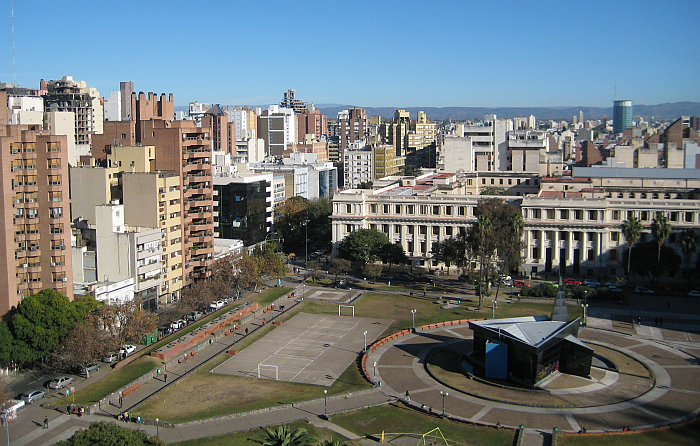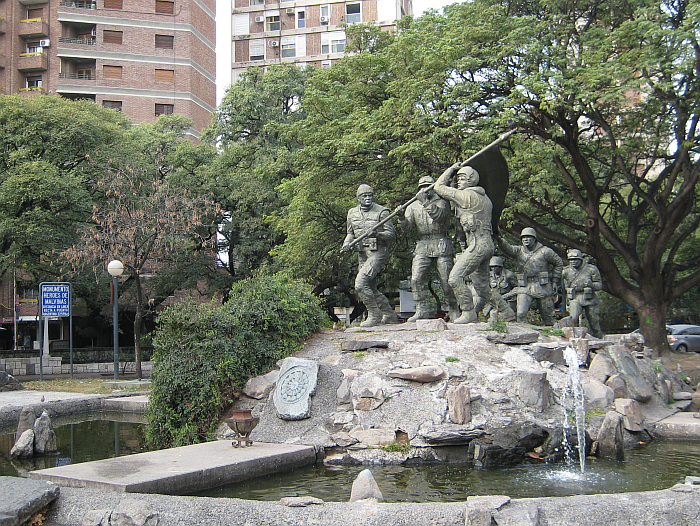Wednesday, 17 April 2024
The Amazing Race 36, Episode 6
Santiago (Chile) - Córdoba (Argentina)

[Looking west from central Córdoba over the Palacio de Tribunales (law courts) toward the Sierras]
Córdoba shares several characteristics with other provincial “second cities” that are overshadowed by much larger national capitals. It’s rarely a primary destination for visits by foreign tourists, who typically pass through only en route to other destinations and stay only briefly. But despite a lack of marquee attractions for tourists, Córdoba has a lot going for it as a less expensive, less pretentious, more laid-back alternative to Buenos Aires for Spanish-language or tango students, digital nomads, and other longer-term visitors.
A major advantage of Córdoba is its location, which gives easy access to open spaces and outdoor activities in the surrounding countryside. Like Denver (or Almaty, Kazakhstan, to give another notable example), Córdoba is a city of the plains at the foot of high mountains. The Sierras de Córdoba that begin just outside the city are part of Argentina’s Central Sierras, the only major mountain range in the middle of the vast flat expanse of the pampas. There are tower blocks of elevator apartment in central Córdoba, but unlike in Buenos Aires, Córdoba is small enough that it doesn’t take long to get out of the city to dude ranches on the pampas (such as the one visited by The Amazing Race for a gaucho cowboy bull-roping challenge) or to hiking, camping, and mountain-biking in the mountains. Despite their isolation, the Central Sierras include significant expanse of highlands, extending more than 200 miles (400 km) from north to south and gradually rising 8,000 feet (2,500 meters) from the center of Córdoba to a peak more than 9,000 ft (2,800 meters) above sea level.
Córdoba is served by relatively few long-haul flights, with none at present to or from the USA. Direct flights on American Airlines that briefly operated to and from Miami were suspended in 2020 and have not resumed. Connections via Buenos Aires typically involve a tedious and inconvenient transfer between the domestic and international airports. The best connections to and from the USA are currently on LATAM via Santiago or Lima, or on COPA via Panama City. Most long-distance transport within Argentina, including to and from Córdoba, is by bus.
The finish line for this leg of The Amazing Race was, appropriately enough, in the Plaza San Martín in the center of city. The racers were given some characteristically Argentine tasks, including identifying cuts of beef at a butcher shop and playing a version of soccer at the historic stadium of the Talleres de Córdoba club. There was an unexplored irony, however, in one of the optional challenges for the racers: identifying fingerprints at a police forensic laboratory.
One of the most noteworthy sites of memory of state terror in Córdoba is a former office of the Provincial Police located down a passage off the Plaza San Martín, the entrance the racers ran past in their final sprint to the finish line. As I described it during an earlier season of The Amazing Race:
In Córdoba, prisoners were confined in underground pits and tortured in open-air courtyards in a small building in the Pasaje Santa Catalina (pedestrian arcade) just off the central Plaza San Martín between the city hall and the main cathedral. I struggled to imagine what passers-by, on their way to or from mass (in Argentina, unlike some Latin American centers of liberation theology, the Catholic Church and priests like Father Jorge Bergoglio, who is now the Pope, largely accommodated themselves to the dictatorship) or dealings with city bureaucrats at the Cabildo, thought when they heard the screams. Today the building houses the provincial Archives of Memory and a must-see little museum of the memory of state terrorism in the province. It’s particularly interesting for putting the “Proceso” in longer-term context: the building housed the provincial police “Red Squad”, where “subversives” were detained and tortured, long before the military dictatorship of 1976-1983. It also includes several rooms of artifacts and images of the people killed and disappeared, vaguely reminiscent of Mexican “Day of the Dead” altars but with their own Argentine flavor.
While fingerprints have been used by police in Argentina and other countries to identify both criminals and targets of state terrorism, fingerprints and other forensic techniques have also been used, in Argentina and elsewhere, to identify the bodies of victims of that state terrorism.
It wasn’t clear in what contemporary police building in Córdoba the fingerprint-identification task on The Amazing Race was supposed to take place. But the contrast with the Pasaje Santa Catalina could scarcely be more striking: One feature of the site of memory in the Pasaje Santa Catalina is a mural of the names of Córdobans who were murdered, “disappeared”, tortured, or detained, rendered in the shape of giant fingerprints on the outside wall of the police building.

[Monument to the Heroes of the Malvinas Islands War, Plaza de la Intendencia, Córdoba]
